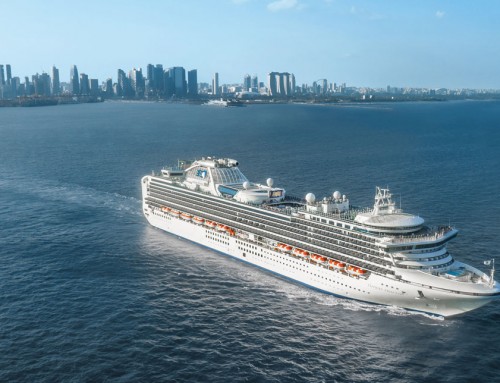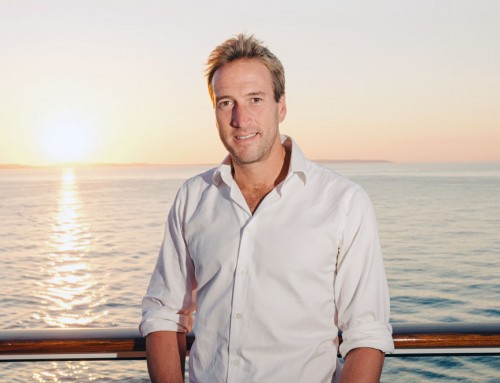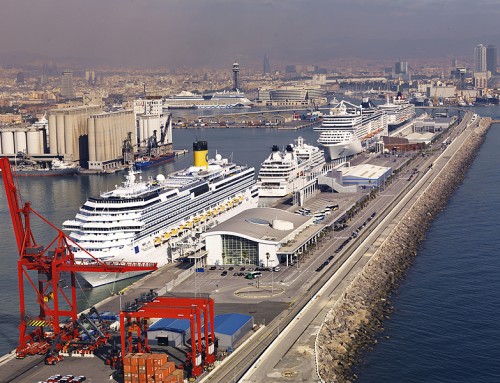This was to be no ordinary shore excursion. That much was apparent when members of the ship’s crew set out in two Zodiac inflatables to construct a temporary jetty for passengers to step ashore.
It became clearer still when we discovered we would be accompanied every step of the way by two armed guards carrying high-powered rifles.
No more than 100 people were allowed ashore at any one time, so we were split into groups to be taken by tender from our ship, Quest for Adventure.
I was in the first group. No time for breakfast, just a heady adrenaline rush when word spread that the landing party had discovered fresh polar bear tracks on the beach.
We might need those armed guards.
We definitely needed warm clothing. Mid-July it may have been, but on the island of Spistbergen, high up inside the Arctic Circle at a latitude of 71 degrees north, the temperatures stay chilly even though the sun is in the sky for 24 hours a day. Only the very brave would have turned this beach visit into an opportunity for swimming.
Jagged mountains all around the magnificent Magdalena Fjord were covered in snow; glaciers reached down to the sea, which was dotted with ice floes and mini bergs.
We stepped ashore from the boat onto the bobbing jetty and then onto the pebble beach at Gravneset. Four fenced-off mounds rising above the
sand looked insignificant until we were told they were the remnants of blubber ovens built by marauding whalers in the 17th century
The graves of 130 men lay behind another fence, but nesting Arctic terns which dive-bombed anyone trying to get too close provided far better protection than the railings.
Through high-powered binoculars, a set of polar bear tracks could be seen in the snow above us, but no-one worried about the possibility of the animal coming close. There may be 3,000 of them on Svalbard, but none had been seen at this beach for years. So we were told.
Unconcerned, the passengers strolled along the strand and drank mulled wine and hot chocolate at the hastily-erected “Most Northerly Bar.”
All too soon it was time to return to the ship to allow the next group over. We ate a belated breakfast by the pool at the aft of Quest, and it was tempting to stay on deck to chat with friends, read a book, or just relax amid the mountains.
Suddenly there was a stir among the passengers. Fingers pointed back towards the beach. Someone had spotted a polar bear loping across the neck of land joining the foot of the cliffs to our landing point.
The adventurers ashore seemed unconcerned. They had not seen the creature. Nor had the two armed rangers there to protect them.
Those of us on deck had to make a hasty decision. Should we take advantage of the situation to get some unique photos of this rare encounter, or had we better get a message to the bridge?
Valour won the day and a warning was radioed across. The passengers were rounded up to get back on the boat while a ranger set off to stalk the bear, which was still getting closer.
Two shots rang out across the still water; they were designed to frighten the animal off rather than injure it, and they seemed to do the trick. The creature splashed into the sea and set off to swim to another part of the fjord.
While Quest for Adventure prepared to sail away, reunited with its full complement of guests, a Zodiac took the ranger off down the fjord to make sure the bear had suffered no ill effects other than the intrusion on its privacy.
Captain Kees Spekman took us for one last spin around the bay, getting as close to a glacier as safety allowed, and then our memorable morning was over.
It had been just one of countless unforgettable experiences on a magnificent voyage of adventure to the largest remaining wilderness in Europe.
From Stavanger an energetic group had hiked to the top of Pulpit Rock – that familiar symbol of the Norwegian fjords that most visitors see only from the waters of Lysefjord, far below its 1,500-ft summit.
Leaving Bronnøysund, we took a 50-minute ferry trip to the Vega archipelago, to visit a museum devoted to the islanders’ harvesting of eider down. With a pair of down-filled mittens on sale in the adjacent souvenir shop for a mind-boggling £100, it didn’t take much effort to calculate that an entire quilt would be unaffordable – even if it did last the promised 100 years.
On to Leknes in the remote Lofoten islands, for an invigorating ride in a RIB – rigid inflatable boat – skimming across the water at up to 40 mph and sighting a solitary sea eagle along the way.
These excursions were relatively tame compared to what lay in store on Svalbard. First stop was Longyearbyen which is slowly dragging itself into the tourist-friendly 21st century but still has the air of the coal-mining frontier town it was for 100 years.
Austere barrack house lodgings have been replaced by chain hotels, and there’s a clutch of trendy bars – although locals are restricted to a monthly alcohol quota. Cruise ship passengers will be smugly aware that drinks back on the ship are a fraction of the price ashore.
Even more remote was the outpost of Ny-Ålesund, at 78° 55′ N, the world’s most northerly inhabited settlement. Hence the rush to send postcards home stamped with the local postmark.
It’s another relic from the coal mining era and there is a memorial to Roald Amundsen, who in 1926, succeeded in reaching the North Pole from here by airship.
Visitors today are restricted to a few paths between the buildings which in summer are occupied by about 200 research scientists from around the world. Fewer than 50 remain year-round.
After Magdalena Fjord, the return journey to Dover took in a sail past Nordkapp, claimed to be the northernmost point in mainland Europe. In fact it is not on the mainland, and there is another point closer to the Pole. But it is the easiest for visitors to get to.
Then it was on to Norway’s Arctic Capital, the visitor-friendly Tromsø; Molde, the so-called town of roses, and Geiranger, the country’s most spectacular fjord, stretching more than 70 miles inland.
Along the way, a team of expert naturalists from ORCA kept a constant watch for wildlife, spotting a remarkable 16 blue whales, as well as beluga, sperm, bottle-nose, pilot and killer whales, porpoise, dolphins, seals, basking shark, walrus, and countless birds.
Throughout the journey, passengers – most of them beyond retirement age but all with active minds and bodies still largely intact – enjoyed sumptuous feasts prepared by ever-smiling executive chef George Streeter, and rolled with laughter at the cheeky banter of cruise director Neil Horrocks.
A real asset to the ship, he is every passenger’s favourite grandson, and is the only person I know who can make a four-question game of Scattergories last for a hilarious 75 minutes. Though I may be biased, because my team won.
But it was the polar bear encounter that remained the highlight of the trip. So much so that Saga should consider exchanging Fox’s Glacier Mints for the Werther’s Originals dished out on every excursion.
WHEN TO GO
There’s a brief season for cruises as far north as Svalbard, between June and August. Outside those months it’s too cold and too dark, unless you’re hoping to catch a glimpse of the Northern Lights.
TOP TIP
Inside cabins are not always the most popular accommodation on a cruise ship, but light sleepers travelling to the Land of the Midnight Sun choose them to avoid their rest being disturbed.
TOP NO-TIP
Gratuities are included in Saga cruise fares, unlike some ships where the cost of tips can exceed £10 per person per day, with another 15 per cent added to bar bills.
DON’T MISS
The Svalbard Museum in Longyearbyen is an excellent introduction to life on Spitsbergen and the archipelago’s inhabitants, from coal miners to reindeer; kittwakes to whales. Admission 75kr adults, 15kr children, 50 kr concessions.
NAME GAME
Next year, following the retirement of Saga Ruby, Quest for Adventure will be sailing as Saga Pearl II.
BOOK IT
Saga Pearl II returns to Svalbard next summer for a 15-night cruise leaving Dover on June 22. Ports of call: Stavanger, Leknes, Longyearbyen, Ny-Ålesund, Magdalena Fjord, Tromsø, Geiranger, and Bergen. Fares from £2,014 including a £200 credit towards the cost of excursions.
saga.co.uk/cruises 0800 504 505
This article was published in the Sunday Mirror on September 22. It does not appear to have been re-published online at Mirror Travel.





I am planning to spend my coming holidays on cruise. Your guide will be helpful in my journey. Thanks for sharing!